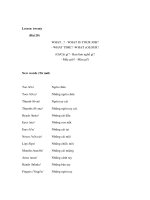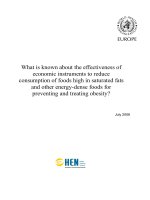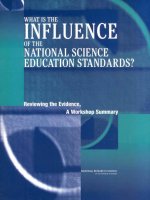What is Morphology
Bạn đang xem bản rút gọn của tài liệu. Xem và tải ngay bản đầy đủ của tài liệu tại đây (1.37 MB, 43 trang )
<span class='text_page_counter'>(1)</span>Chapter 1 What is Morphology.
<span class='text_page_counter'>(2)</span> 1.1 Introduction Morphology is the study of word formation, including the ways new words are coined in the languages of the world, and the way forms of words are varied depending on how they’re used in sentences..
<span class='text_page_counter'>(3)</span> 1.2 What is a word? Linguists define a morpheme as the smallest unit of language that has its own meaning. Simple words like giraffe, wiggle, or yellow are morphemes, but so are prefixes like re- and pre- and suffixes like -ize and -er. Let us now define a word as one or more morphemes that can stand alone in a language. Words that consist of only one morpheme, like the words in (1), can be termed simple or simplex words. Words that are made up of more than one morpheme, like the ones in (2), are called complex: Giraffe opposition Fraud intellectual.
<span class='text_page_counter'>(4)</span> 1.3 Words and Lexemes, types and tokens . . My friend and I walk to class together, because our classes are in the same building and we dislike walking alone.. If we are counting every instance in which a word occurs in a sentence, regardless of whether that word has occurred before or not, we are counting word tokens. If we count word tokens in the sentence above, we count 21. If, however, we are counting a word once, no matter how many times it occurs in a sentence, we are counting word types..
<span class='text_page_counter'>(5)</span> Lexemes A still different way of counting words would be to count what are called lexemes. Lexemes can be thought of as families of words that differ only in their grammatical endings or grammatical forms; singular and plural forms of a noun (class, classes), present, past, and participle forms of verbs (walk, walks, walked, walking), different forms of a pronoun (I, me, my, mine) each represent a single lexeme. One way of thinking about lexemes is that they are the basis of dictionary entries. The sentence then has 16 lexemes. .
<span class='text_page_counter'>(6)</span> 1.4 But is it really a word? What if dictionaries differ in whether they list a particular word? For example, the Official Scrabble Player’s Dictionary lists aalii but not bouncebackability. The Oxford English Dictionary On-Line doesn’t list aalii, but it does list bouncebackability. So which one is right? Further, what about words like cot potato or freshmore that don’t occur in any published dictionary yet, but can be encountered in the media? The former, according to Word Spy (www.wordspy.com) means a baby who spends too much time watching television (Americans might use the term crib potato instead of cot potato), and the latter is a second-year high school student in the US who has to repeat a lot of first-year classes. And what about the word cot potatodom? What does it mean????. .
<span class='text_page_counter'>(7)</span> . The Lexicon. The mental lexicon a sort of internalized. dictionary. that. contains an enormous number of words that we can produce, or at least understand when we hear them. But we also have a set of word. formation. rules. which. allows us to create new words and understand new words when we encounter them..
<span class='text_page_counter'>(8)</span> Why do languages have morphology? One. reason for having morphology is to form new lexemes from old ones. We will refer to this as lexeme formation. Lexeme formation can do one of three things. 1 - It can change the part of speech (or category) of a word, for example, turning verbs into nouns or adjectives, or nouns into adjectives. V→ N: amuse → amusement V → A: impress → impressive N → A: monster → monstrous.
<span class='text_page_counter'>(9)</span> 2- Some rules of lexeme formation do not change category, but they do add substantial new meaning: A → A ‘negative A’ happy → unhappy N → N ‘place where N lives’ orphan → orphanage V → V ‘repeat action’ wash → rewash 3- And some rules of lexeme formation both change category and add substantial new meaning: V → A ‘able to be Ved’ wash → washable N → V ‘remove N from’ louse → delouse.
<span class='text_page_counter'>(10)</span> Why have rules of lexeme formation? . . 1- Rules of lexeme formation allow for a measure of economy in our mental lexicons: we can recycle parts, as it were, to come up with new words. For example, if you wanted to talk about the process or result of amusing someone, you couldn’t use amusement, but would have to have a term like zorch instead. 2- Inflectional word formation is word formation that expresses grammatical distinctions like number (singular vs. plural); tense (present vs. past); person (first, second, or third); and case (subject, object, possessive), among others..
<span class='text_page_counter'>(11)</span> What can you note? 1-Wo jian guo yi zhi chang jing lu. I see past one CLASSIFIER giraffe 2- Wo jian guo liang zhi chang jing lu I see past two CLASSIFIER giraffe . Some concepts that are expressed via inflection in some languages are expressed by other means in other languages..
<span class='text_page_counter'>(12)</span> 10 Min. Do the Exercises Page 9.
<span class='text_page_counter'>(13)</span> Chapter 2: Words, dictionaries and the mental lexicon Do. we have to rely on the dictionary all the time?. Can. memorizing all the words in the dictionary help people in learning a language?. What. is a mental lexicon?.
<span class='text_page_counter'>(14)</span> Nonces, mistakes and mountweazels In a dictionary we can find 1- words that are labeled as ‘nonce’, meaning that they’ve been found just once, often in the writing of someone important, but that nevertheless don’t seem to occur anywhere else. A) The OED On-line, for example, lists as a nonce the word agreemony, which they define as ‘agreeableness’, and illustrate with a single quotation from the seventeenth-century writer Aphra Behn. B) We can find the word umbershoot used by James Joyce in Ulysses, about which the OED maddeningly says only “meaning obscure”!.
<span class='text_page_counter'>(15)</span> 2- Very extensive dictionaries like the OED sometimes also contain words that they identify as mistakes. For example, we can find an entry for the word ambassady, which occurs in a single quotation from 1693 and is, according to the OED, perhaps a mistake, where the author might have meant the word ambassade “the mission or function of an ambassador.” 3- And finally, there are what have come to be called ‘mountweazels’. A mountweazel is a phony word that is inserted into a dictionary so that its makers can identify lexicographic piracy. 4- The conclusion that we are inexorably led to is that we cannot rely on dictionaries to answer the question “Is xyz a word?” On the one hand, dictionaries don’t list all the words of any language. They can’t list all derivatives with living prefixes and suffixes, or all technical, scientific, regional, or slang words..
<span class='text_page_counter'>(16)</span> The mental lexicon By. the mental lexicon I mean the sum total of everything an individual speaker knows about the words of her language. This knowledge includes information about pronunciation, category (part of speech), and meaning, of course, but also information about syntactic properties, level of formality, and what lexicographers call ‘range of application’, that is, the specific conditions under which we might use the word..
<span class='text_page_counter'>(17)</span> How many words?. Psycholinguists. estimate that the average Englishspeaking six-year-old knows 10,000 words, and the average high-school graduate around 60,000 words..
<span class='text_page_counter'>(18)</span> How we acquire our mental lexicon? Learning of new words is a simple matter of association: someone points at something and says “flurge” and you learn that that something is called a flurge. This may be the way that we learn some words, but surely not the way we learn the majority of words in our mental lexicons. And even if someone points and says a word, it is often not clear from the context what exactly is being pointed out. Psycholinguists sometimes call this the Gavagai problem. Read page 16. .
<span class='text_page_counter'>(19)</span> The. psycholinguist Susan Carey has called fast mapping (Carey 1978). Fast mapping is the ability to pick up new words on the basis of a few random exposures to them. Psycholinguists have proposed a number of other strategies that both children and adults seem to use in learning new words. One might be called the Lexical Contrast Principle, the language learner will always assume that a new word refers to something that does not already have a name. A second word learning strategy might be called the Whole Object Principle, the new word refer to the whole object rather than its parts. A related strategy might be dubbed the Mutual Exclusivity Principle, Subjects, in other words, will assume that if an object already has a word for it, the new word cannot be synonymous with those words..
<span class='text_page_counter'>(20)</span> 2.3.3 The organization of the mental lexicon: storage versus rules the mental lexicon is not organized alphabetically like a dictionary. it is a complex web composed of stored items (morphemes, words, idiomatic phrases) Our evidence for this organization comes from experiments using both normal subjects and subjects with some sort of genetic disorder or trauma to the brain. The important point here is that when we hear this sound at the end of a verb we know (unconsciously) that it’s voiceless, and apply the past tense rule to it in the usual way. .
<span class='text_page_counter'>(21)</span> With or against we. might assume that once a past tense has been formed, it is entered whole in our mental lexicon, and we retrieve it whole just as we would the present tense form. This. hypothesis, however, may not be correct..
<span class='text_page_counter'>(22)</span> We learn words and apply rules 2.3.4. Evidence from aphasia people whose language faculty has been impaired due to stroke or other brain trauma – show that there must be a past tense rule that speakers use for regular forms. Some aphasics display agrammatism; this means that they have difficulty in producing or processing function words in sentences, but can still produce and understand content words. Other aphasics display jargon aphasia; these aphasics produce fluent sentences using function words, but have trouble producing and understanding content words. . For agrammatic aphasics, the rule is unavailable, presumably because the part of the brain has been damaged that apparently allows us to apply morphological rules, but the irregular forms are still accessible from an undamaged part of the brain. For jargon aphasics, the irregular forms have been lost because the part of the brain that apparently allows access to stored forms has been damaged, but the regular rule is still intact..
<span class='text_page_counter'>(23)</span> 2.3.5. Evidence from imaging studies Imaging studies of normal subjects, such as those done with PET scans seem to show the same thing. PET scans measure the level of blood flow to different parts of the brain, which in turn shows us areas of activation in those parts. 2.3.6 Evidence from genetic disorders Similar conclusions follow from studies of two different genetic disorders – Specific Language Impairment (SLI)– that affect language in different ways. Individuals with SLI are generally of normal intelligence and have no hearing impairment. But they are slow to produce and understand language, and their speech is characterized by the omission of various inflectional morphemes..
<span class='text_page_counter'>(24)</span> 10 Min. . Compare and contrast two dictionaries form the ones below.
<span class='text_page_counter'>(25)</span> Chapter 3: Lexeme Formation : the familiar un / wipe head / bracelet McDonald / ize / ation Some of the morphemes in (1) can stand alone as words: wipe, head, bracelet, McDonald. These are called free morphemes. The morphemes that cannot stand alone are called bound morphemes. In the examples above, the bound morphemes are un-, -ize, and -ation. .
<span class='text_page_counter'>(26)</span> Bound morphemes come in different varieties. Those in (1) are prefixes and suffixes; the former are bound morphemes that come before the base of the word, and the latter bound morphemes that come after the base. Together, prefixes and suffixes can be grouped together as affixes. New lexemes that are formed with prefixes and suffixes on a base are often referred to as derived words, and the process by which they are formed as derivation. The base is the semantic core of the word to which the prefixes and suffixes attach. For example, wipe is the base of unwipe.. .
<span class='text_page_counter'>(27)</span> How many morphemes ? Pathology. Psychopath. => path(o) logy. => pyscho. path.
<span class='text_page_counter'>(28)</span> Words. like pathology and psychopath are made up of nothing but affixes! NO. Morphologists. therefore make a distinction between affixes and bound bases. Bound bases are morphemes that cannot stand alone as words, but are not prefixes or suffixes.. Sometimes,. as is the case with the morphemes path it can occur either before or after another bound base: path precedes the base ology, but follows the base psych(o);.
<span class='text_page_counter'>(29)</span> Dermatitis Endoderm.
<span class='text_page_counter'>(30)</span> Why don’t we call them suffixes? . . But not all bound bases are as free in their placement as path; for example, psych(o) and ology seem to have more fixed positions, the former usually preceding another bound base, the latter following. Similarly, the base -itis always follows, and endo- always precedes another base. One reason is that all of these morphemes seem in an intuitive way to have far more substantial meanings than the average affix does. path means ‘sickness’, derm means ‘skin’ and -itis means ‘disease’. Semantically, bound bases can form the core of a word, just as free morphemes can. Figure 3.1 summarizes types of morphemes..
<span class='text_page_counter'>(31)</span>
<span class='text_page_counter'>(32)</span> Root and Stem In. languages with more inflection than English, there is often no such thing as a free base: all words need some sort of inflectional ending before they can be used. Or to put it differently, all bases are bound..
<span class='text_page_counter'>(33)</span> Word Formation Processes. Primary/Major Secondary/Minor (4) Derivation (1) Compounding (2) Conversion (3) blending Acronyms Clipping. Coinage Borrowing backformation.
<span class='text_page_counter'>(34)</span> 3.3 Affixation 3.3.1. Word formation rules prefixes and suffixes usually have special requirements. Some of these requirements concern the phonology (sounds) of their bases, and others concern the semantics (meaning) of their bases. but the most basic requirements are often the syntactic part of speech or category of their bases. a. -ness on adjectives: redness, happiness, wholeness, commonness, b. -ness on nouns: *chairness, *ideaness, *giraffeness c. -ness on verbs: *runness, *wiggleness, *yawnness.
<span class='text_page_counter'>(35)</span> Rule. for -ness (first version): Attach -ness to an adjective Rule for -ness (second version): -ness attaches to adjectives ‘X’ and produces nouns meaning ‘the quality of X’. It has no phonological restrictions. We. have just constructed what morphologists call a word formation rule, a rule which makes explicit all the categorial, semantic, and phonological information that native speakers know about the kind of base that an affix attaches to and about the kind of word it creates.. Check 36.
<span class='text_page_counter'>(36)</span> 3.3.2 Word structure unhappiness = un happy ness 1 2 . . The order of attachment of affixes is important..
<span class='text_page_counter'>(37)</span> Examples. of tree diagrams:. Adjective Un. +. Noun. adj. +. system root/ free morph. RULE 2. atic. RULE 1.
<span class='text_page_counter'>(38)</span> (p 85). Adv. Adj. +. ly. adj. +. RULE 4. al. RULE. 3 un +. adj. RULE. 2 noun. +. atic. SYSTEM SYSTEMATIC UNSYSTEMATIC UNSYSTEMATICAL UNSYSTEMATICALLY. RULE 1 Derivational Bound Grammatical Morphemes.
<span class='text_page_counter'>(39)</span> Repureify. = Re Pure ify.
<span class='text_page_counter'>(40)</span> 3.3.3 What do affixes mean? . . 1- In some cases, affixes seem to have not much meaning at all. Affixes like these are sometimes called transpositional affixes, meaning that their primary function is to change the category of their base without adding any extra meaning. Page 40 for the other types.
<span class='text_page_counter'>(41)</span> Page 40 personal. affixes negative and privative affixes prepositional and relational affixes quantitative affixes evaluative affixes.
<span class='text_page_counter'>(42)</span> Affixal polysemy All of the forms derived with -er denote concrete nouns, either persons or things, related to their base verbs by participating in the action denoted by the verb, although sometimes in different ways. This cluster of related meanings is called affixal polysemy . A. writer skater b. printer c. loaner fryer (i.e., a kind of chicken).
<span class='text_page_counter'>(43)</span> Remark: . Words with double meaning might have different morphological structures.. e.g. unlockable (85) « not able to be locked » « able to be unlocked » ADJ UN ABLE. ADJ +. ADJ. VERB. +. VERB. ABLE. UN. +. +. VERB. LOCK LOCK this is because the prefix ‘un’ can combine with an adjective or with a verb. E.g. ‘unbottonable’/ ‘unzippable’.
<span class='text_page_counter'>(44)</span>









